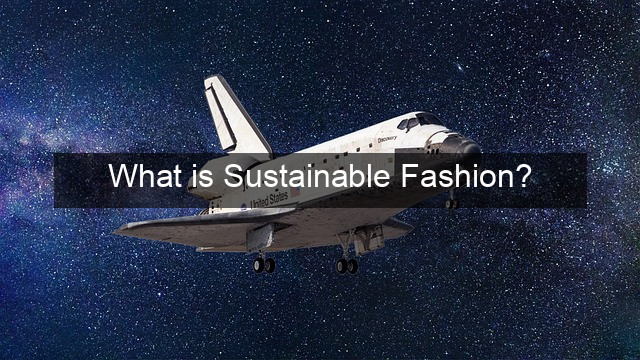What is Sustainable Fashion?
- What is Sustainable Fashion?
- What is Sustainable Fashion?
- Understanding the Core Principles of Sustainable Fashion
- Environmental Stewardship
- Social Responsibility
- Economic Viability
- Embracing Sustainable Fashion in Your Life
- Conscious Consumption
- Supporting Ethical Brands
- Caring for Your Clothes
- The Future of Fashion
- Innovation and Technology
- Collaboration and Transparency
- Conclusion
- Frequently Asked Questions
- What are some sustainable fabrics?
- How can I tell if a brand is truly sustainable?
- What is fast fashion?
- What is a circular economy in fashion?
- How can I be more sustainable with my existing wardrobe?

What is Sustainable Fashion?
The fashion industry, a global behemoth, has long been criticized for its detrimental environmental and social impact. From overflowing landfills choked with discarded clothing to exploitative labor practices, the traditional fashion model is demonstrably unsustainable. But a powerful counter-movement is gaining momentum: sustainable fashion. This approach seeks to revolutionize the industry by prioritizing ethical production, environmental responsibility, and social justice. It’s a holistic reimagining of how we create, consume, and dispose of clothing, aiming to minimize harm and maximize benefit for people and the planet. This article will delve into the core principles of sustainable fashion, exploring its multifaceted nature and offering practical ways to embrace a more conscious approach to our wardrobes.
Understanding the Core Principles of Sustainable Fashion
Environmental Stewardship
At its heart, sustainable fashion champions environmental protection. It acknowledges the significant strain the industry places on natural resources, from water pollution caused by textile dyeing to greenhouse gas emissions from manufacturing and transportation. Sustainable practices aim to minimize this impact through innovative solutions and responsible sourcing.
This includes utilizing eco-friendly materials like organic cotton, recycled fibers, and innovative plant-based alternatives like Tencel and Piñatex. It also means reducing water consumption and chemical usage in production processes, opting for closed-loop systems and minimizing waste.
Furthermore, sustainable fashion encourages transparency and traceability in supply chains, ensuring accountability and minimizing the risk of environmental damage throughout the production journey.
Social Responsibility
Beyond environmental concerns, sustainable fashion tackles the social injustices prevalent in the industry. Exploitative labor practices, unsafe working conditions, and unfair wages are unfortunately commonplace in conventional garment manufacturing. Sustainable fashion advocates for fair labor standards, ensuring safe and healthy working environments and promoting fair wages for all workers.
This includes empowering workers, promoting ethical sourcing practices, and supporting initiatives that improve the livelihoods of those involved in the fashion supply chain. It also means fostering greater transparency and accountability within brands, allowing consumers to make informed choices that align with their values.
Ultimately, sustainable fashion strives to create a more equitable and just industry that values the well-being of all individuals involved in the creation of our clothes.
Economic Viability
Sustainable fashion isn’t just about minimizing harm; it’s also about creating a viable economic model for the future. This means moving away from the fast-fashion paradigm of constant consumption and disposability towards a more circular economy. This model emphasizes durability, repairability, and recyclability, extending the lifespan of garments and minimizing waste.
It also encourages innovative business models like clothing rental services, secondhand markets, and upcycling initiatives, which offer alternative ways to access and enjoy fashion without contributing to overproduction and waste. These models can create new economic opportunities and contribute to a more resilient and sustainable fashion ecosystem.
By embracing circularity and promoting mindful consumption, sustainable fashion aims to build a more robust and responsible industry that benefits both people and the planet.
Embracing Sustainable Fashion in Your Life
Conscious Consumption
One of the most impactful ways to support sustainable fashion is through conscious consumption. This involves being mindful of our purchasing habits and making informed choices about the clothes we buy. Ask yourself: Do I really need this item? Where was it made? What is it made of? By considering these questions, we can shift away from impulsive purchases and embrace a more intentional approach to building our wardrobes.
Choosing quality over quantity, investing in durable pieces, and supporting brands that prioritize sustainability are key components of conscious consumption. It also means embracing secondhand clothing, repairing and upcycling existing garments, and minimizing textile waste.
By consuming less and choosing wisely, we can significantly reduce our environmental footprint and support a more sustainable fashion system.
Supporting Ethical Brands
Researching and supporting brands that prioritize sustainability is crucial. Look for certifications like Fair Trade, GOTS (Global Organic Textile Standard), and B Corp, which indicate a commitment to ethical and environmental practices. Transparency is key, so seek out brands that openly share information about their supply chains and production processes.
Many ethical brands utilize sustainable materials, implement fair labor practices, and minimize their environmental impact. By choosing to support these brands, we can vote with our wallets and encourage greater responsibility within the fashion industry.
Supporting ethical brands not only promotes positive change within the industry, but it also allows us to curate wardrobes filled with pieces that align with our values.
Caring for Your Clothes
Extending the lifespan of our clothes is another important aspect of sustainable fashion. Proper care and maintenance can significantly reduce the need for replacements and minimize textile waste. This includes washing clothes less frequently, using gentle detergents, and air-drying whenever possible.
Learning basic repair skills, like mending holes and replacing buttons, can also help us keep our clothes in good condition for longer. When garments are beyond repair, consider upcycling them into new items or donating them to charity rather than discarding them.
By taking good care of our clothes, we can maximize their lifespan and reduce our overall consumption, contributing to a more sustainable fashion cycle.
The Future of Fashion
Innovation and Technology
The future of sustainable fashion lies in innovation and technology. New materials, such as mushroom leather and lab-grown textiles, are being developed to reduce reliance on conventional resources. Advanced recycling technologies are also emerging, allowing for the breakdown and reuse of textile waste.
3D printing and other digital manufacturing techniques are being explored to minimize waste and create more personalized and on-demand production processes. These advancements hold immense potential for transforming the fashion industry and creating a more sustainable future.
By embracing these innovations, the fashion industry can move towards a more circular and resource-efficient model, minimizing its environmental impact and creating new possibilities for design and production.
Collaboration and Transparency
Collaboration and transparency are essential for driving positive change within the fashion industry. Brands, designers, manufacturers, and consumers must work together to create a more sustainable system. Open communication and information sharing are crucial for building trust and accountability.
Industry-wide initiatives and collaborations can help establish common standards and best practices for sustainability. Consumer awareness and demand for ethical and sustainable products are also driving change, pushing brands to adopt more responsible practices.
By working together, we can create a more transparent and accountable fashion industry that prioritizes sustainability and ethical practices.
Conclusion
Sustainable fashion represents a fundamental shift in how we think about clothing. It’s a movement that challenges the status quo and calls for a more responsible and ethical approach to the industry. By embracing conscious consumption, supporting ethical brands, and caring for our clothes, we can all play a role in creating a more sustainable future for fashion.
The journey towards a truly sustainable fashion industry requires ongoing effort and collaboration, but the potential benefits for people and the planet are immense. By embracing the principles of sustainability, we can transform the fashion industry into a force for positive change.
Frequently Asked Questions
What are some sustainable fabrics?
Sustainable fabrics include organic cotton, hemp, linen, Tencel, recycled polyester, and innovative materials like Piñatex (made from pineapple leaf fibers) and mushroom leather.
How can I tell if a brand is truly sustainable?
Look for certifications like Fair Trade, GOTS, and B Corp. Research the brand’s website and look for information about their supply chain, materials, and labor practices. Transparency is key.
What is fast fashion?
Fast fashion refers to the rapid production of trendy, inexpensive clothing, often characterized by low quality and exploitative labor practices. It encourages a culture of overconsumption and contributes significantly to textile waste.
What is a circular economy in fashion?
A circular economy in fashion aims to minimize waste and maximize the lifespan of garments through reuse, repair, recycling, and upcycling. It moves away from the linear “take-make-dispose” model.
How can I be more sustainable with my existing wardrobe?
Care for your clothes properly to extend their lifespan. Repair damaged items, upcycle old clothes into new creations, and donate or sell unwanted garments instead of throwing them away.
| Sustainable Practice | Impact |
|---|---|
| Choosing organic cotton | Reduces pesticide use and water pollution |
| Supporting fair trade | Ensures fair wages and safe working conditions |
| Repairing clothes | Reduces textile waste and extends garment lifespan |


